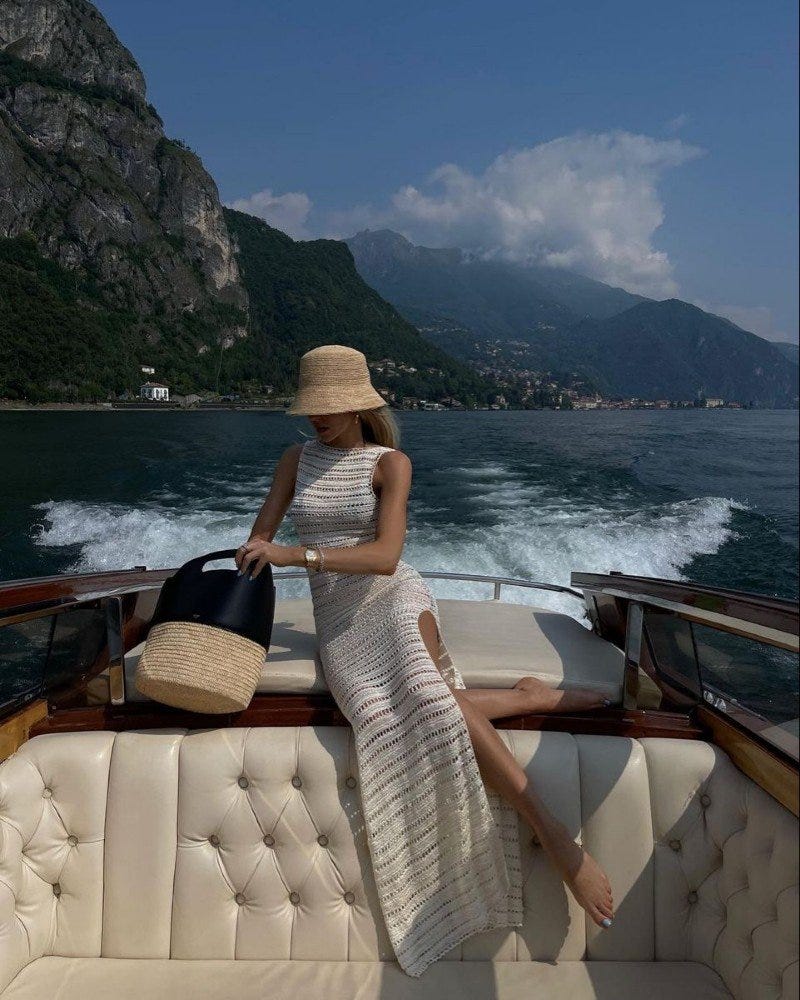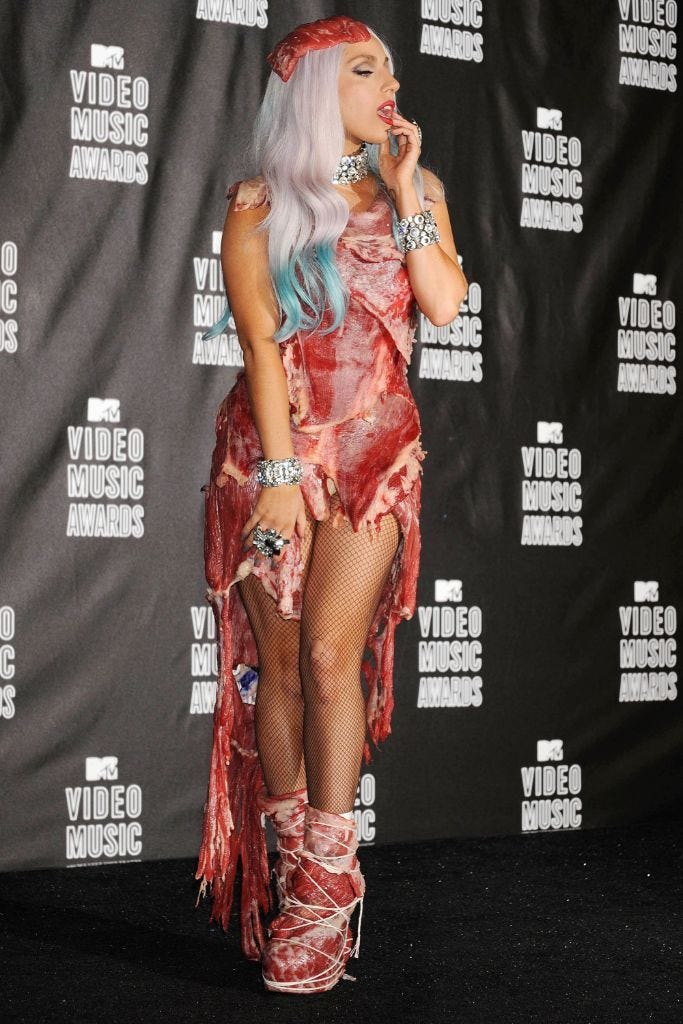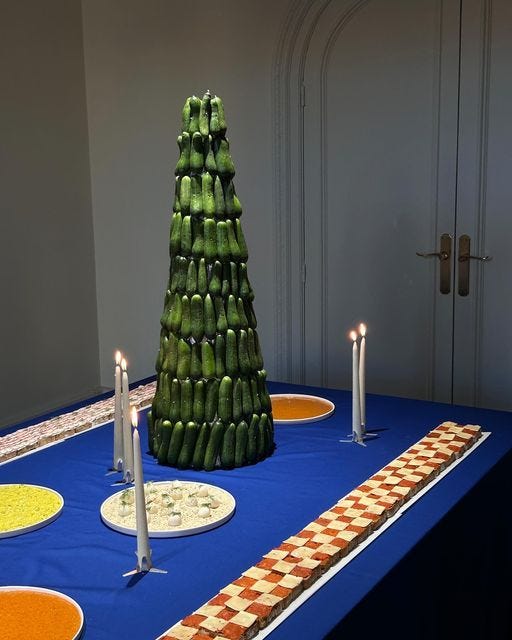"TASTE"- what it is, isn't, & how to develop it (or not)
taste doesn't matter. but you do. and a word about tabis.
What is taste even?
And why do we strive to have it? Why does it feel… important (or… classist)? Why is it, in some subcultures (or maybe all), a marker of relevance and status?
I think it's because we have a skewed perception of what it fundamentally is (or should be). There’s a world where our taste works with us, not against us. Let’s talk about it.
what taste is:
Personal opinion & a discerning eye (can interplay with the other pillars of personal style... example: taste can be influenced by your environment, but shouldn’t be defined by it entirely. Which leads me to...)
Exposure, experience (broadening your worldview)
Aesthetic/design awareness
Contextual understanding
A skill that can be developed
A reflection of the self, society, & the psyche
Taste is the byproduct of our worldview, the measure of our exposure to varied newness, & the invisible thread that ties together our emotional, psychological, and cultural instincts. Taste is a skill (developing your eye for aesthetics) that can be learned and actioned upon (exposing yourself to new cultures, perspectives, art, design, & challenging what you know).
And, well yes. I do think neurodivergent brains develop their taste with more ease, but that’s a whole other newsletter (that I will absolutely write) for my fellow ADHD divas.
To dive deeper- taste is what draws us toward one aesthetic over another—a reflection of what we value, what we crave, and even what we lack. There’s this NPR piece from Alain de Botton that I found super interesting. He suggests that taste is a mirror: what we call beautiful often represents qualities or feelings we long to bring into our lives.
“Take someone who loves calm, empty, pure, minimalist rooms... Far from this person actually being calm and pure inside, he or she is very likely to be oppressed by a fear of disintegration and panic. Take the widespread modern love for the rustic country style... It’s, in fact, our excessive modernity... which has left us longing for some of the qualities of the old and the rural.” - Alain de Botton (NPR, 2006)
what taste isn’t:
Identifying trends
Copycatism (not to be confused with experimenting with your style and being inspired by others, which is a normal and healthy part of developing your preferences and eye for what you like)
One thing that one group that you perceive as cool does/wears/etc. (there is no such thing as singular “good” taste)
Expensive items (have you seen the way most rich people dress?)
Something that can be bought (mostly. You’ll see what i mean)
The same thing as personal style
You can view someone or something as having taste and mimic it. I’ll give you that!! But that doesn’t necessarily mean you’re developing *your* taste (although there’s an exception where this happens and its part of your experimentation and discovery process- ie. you meet someone who’s style and taste reflects subcultures and interests that you haven’t explored, et cetera).
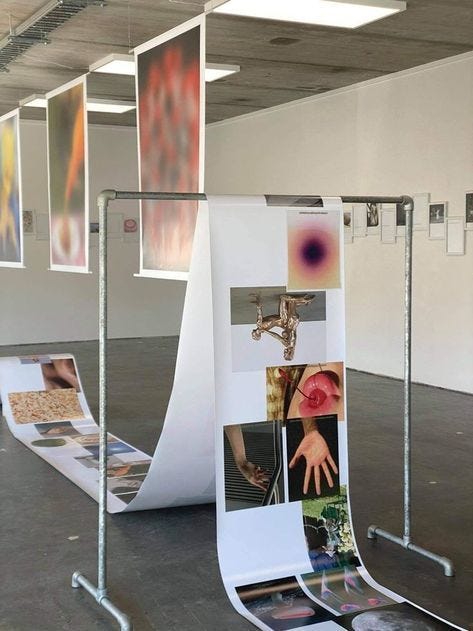
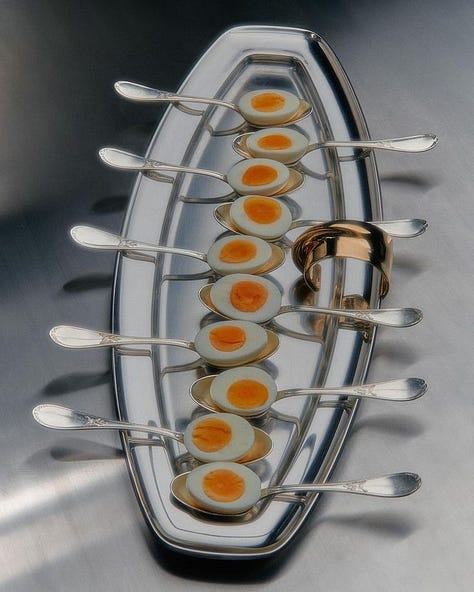
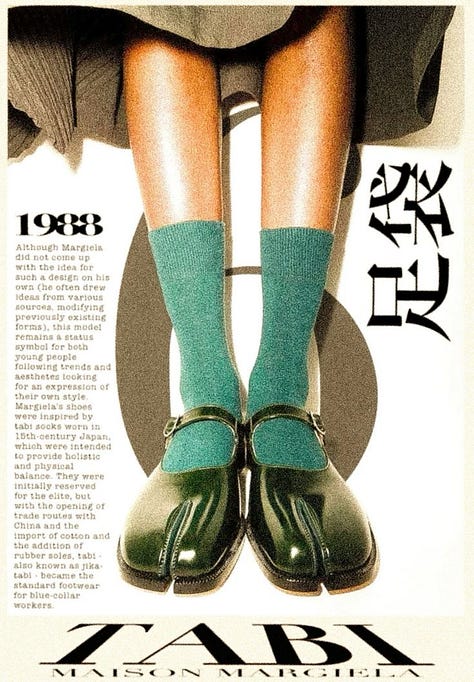
so, can taste be bought? (& a word on tabis)
Short answer: no mostly but yes kind of- but no.
“We’re drawn to call something beautiful whenever we detect that it contains in a concentrated form those qualities in which we personally or our societies, more generally, are deficient.” - Alain de Botton (NPR, 2006)
No because fundamentally taste is the exploration and development of our internal creative compass, it has nothing to do with what we’re buying and why we’re buying it.
And if this entire article wasn’t me overanalyzing (if i don’t overanalyze fashion i’ll overanalyze my emotions), the easy answer is duh of course you can buy something that you find “of good taste.” BUT! Because I’m overanalyzing (your lucky day), the item you’re buying has nothing to do with your taste. And with this section, i’m speaking more to the idea that you saw Regina George wearing tabis so you bought tabis. You view Regina George as the pinnacle of taste. But you don’t view yourself that way. And generally, imo, if you’re buying something because you think it makes you look like you have good taste, you don’t have good taste. And I don’t even mean that in a brash way, I mean it in the sense that you may be disconnected from yourself and your creative compass, or be more trusting of others' eyes than your own. But I will say...
Yes kind of because sometimes taste isn’t in reference to the individual, but to a larger group or subculture. Taste, or fashion overall, is often utilized and tangled up in symbolizing status or even as a signal, or visual cue, communicating to specific communities that you are flocking to. And of course, since style in general is communication, we find ourselves using it to express things beyond just the internal world that influences our personal style. As Alain de Botton put it, we find ourselves expressing or seeking what we feel we lack through what we wear and how we present ourselves- whether that’s belonging, status, power, peace, or to be seen. (an example: as I write this I’m reminded of how many videos I see pop up on YouTube with the title “how to dress rich”, and the working-class/middle-class obsession with “quiet luxury” as a means to survive and achieve what we feel we lack through dress).
taste & class
For the sake of this conversation, I feel like it might be helpful to differentiate between personal taste and taste-at-large, or rather distinguish that, in my opinion, they are two versions of taste under the taste umbrella (at this point I have to wonder if I’ve gone too far. But let’s continue.) Let's discuss the way we, “society”, view taste-at-large when it comes to class.
In his 1979 book Distinction: A Social Critique of the Judgment of Taste, sociologist Pierre Bourdieu discusses how taste is heavily influenced by a person's social class and their level of "cultural capital," meaning the knowledge, skills, and behaviors associated with a particular social group. In fact, he argues that taste, in general, is not a matter of personal preference or inherent quality, but is socially constructed and shaped by one's “cultural capital” AKA class. Hence, why I make a distinction between taste-at-large like he is discussing here, and the journey of developing a personal aesthetic taste.
Ever noticed how taste mimicking is usually that of the upper-class? And how “bad taste” is often associated with the working-class (consider terms like “trailer-trash”)? If bad taste is being mimicked, it’s usually through the lens of camp. Here’s my take (one of many, clearly): Taste is influenced greatly by exposure and access to new things, AKA expanding your worldview. And there is inherently a socioeconomic factor to this overall (but I’ll talk about accessible ways to develop taste at the end of this convo!)- and instead of saying someone has bad taste, which is ludicrous since taste is subjective anyways, I’d rather suggest that they haven’t had access to the same influences, ideas, aesthetics, and paths that could help them in developing their creative eye (ie. their personal taste). But they don’t inherently just have “bad taste.” And frankly, being able to understand “bad taste” so well that you see the aesthetic interest and value in it a la John Waters is so much cooler than just like… idk buying a Birkin.
Again, taste is a skill, and anyone can develop it… IF they want. I reject the idea that taste is objectively important, or looks like one thing. It can be an incredibly fulfilling and engaging way to interact with yourself interacting with the world, art, design, & creativity. If you want it to be, it can be the antidote to a lack of inspiration, to brain rot. It can be a journey of curiosity, learning new things, et cetera.
Basically, even though I am talking a lot, ultimately this doesn’t matter. LOL.
With all of this considered, taste- in the sense of taste at large or the taste of a specific community or subculture- can be mimicked or bought. We can mimic up the wazoo. But anyways back to the question of if taste can be bought…
No again. And this also feels like a good time to remind you again of how aesthetically bad a lot of rich people dress.
While some communities may value a specific kind of niche taste as a signal that your interests may align (or the more convoluted idea of status within that community), it doesn’t reflect your personal taste, and won’t sustainably be satisfying or interesting to you long-term.
And I do think subculture signaling (this could be an interesting newsletter topic on its own, no?) is fairly authentic and natural, but two things can happen when it comes to dressing for a certain status, group of people, or even for perceived lack- you lose your sense of identity and personal taste when you become overly reliant on this version of the taste pursuit.
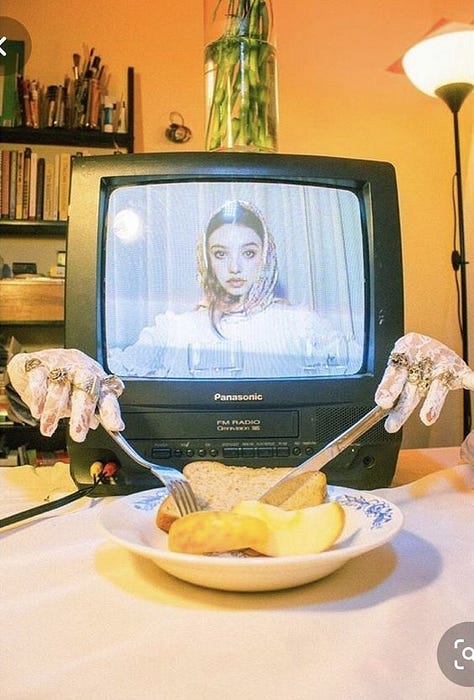


When we rely on “taste mimicking” in whatever form it takes, we might find that we ultimately aren’t satisfied with how our taste, or rather how the way we are approaching taste, is influencing our personal style. Because we are chasing a feeling or quality that we think the aesthetic, the item, will give us. If we sit too long in being informed by what we feel we lack, or being passively influenced by our communities and subcultures, we will never be satisfied. Only when we go internal, into the world of trusting, valuing, and respecting ourselves, being curious and engaged, can we give ourselves the things we lack, or feel we lack (in our lives, and in our closet).
the internet’s role in our influences
Since taste can be influenced by what we are exposed to, I think there is something to be said here about trend cycles and algorithmic internet echo chambers diluting our exposure to newness-and encouraging a handful of one size fits all “cool and tasteful” aesthetics. Frankly, we are exhausted (especially zillenials, gen z and younger) and have acclimated to being overfed short-form brain rot scrolling as our main form of downtime and engagement.
So quite honestly, of course, we’ve lost touch with what it means to develop taste in a personal and engaging way. Its easier to observe, consume, and mimic versus engaging with our world deeper right now. No wonder we are never truly satisfied with our style and our tastes, it's so hard to hear our own voices right now. I think it might have to be an active pursuit on our part.
a short story
You’re at an experimental art show featuring the coolest local artists, some (maybe you) have described it as the hottest, chicest event in town. You arrive, its odd that no one is looking at the art, but maybe they already did. Everyone is mingling, wearing their Rick Owens tops and gorpcore pants. eating crudités from a food sculpure or dipping bread into a butter candle. Mingling it is, surely have a lot in common with these people. You’re finding it a little hard to enter into a conversation, maybe you say something about the art and get a strange look. Naturally, you’re feeling weird now- out of place. But why? These people don’t even know you, why does it seem like they already don’t like you? You’re at the same event, doing the same thing. You have the same interests, maybe even some of the same friends. Why do you feel like such… an outsider? You’ve only been here for 20 minutes. You look around and you realize.
You didn't wear your tabis. (How dare you)
(disclaimer: i am not a tabi hater. i am tabi supporter and tabi lover. in fact, consider this take a protection of tabi integrity and lore. just had to say that in case there is a pair of Margiela black tabi slippers painted in light pink from spring 2002 reading this.)
the difference between taste & personal style

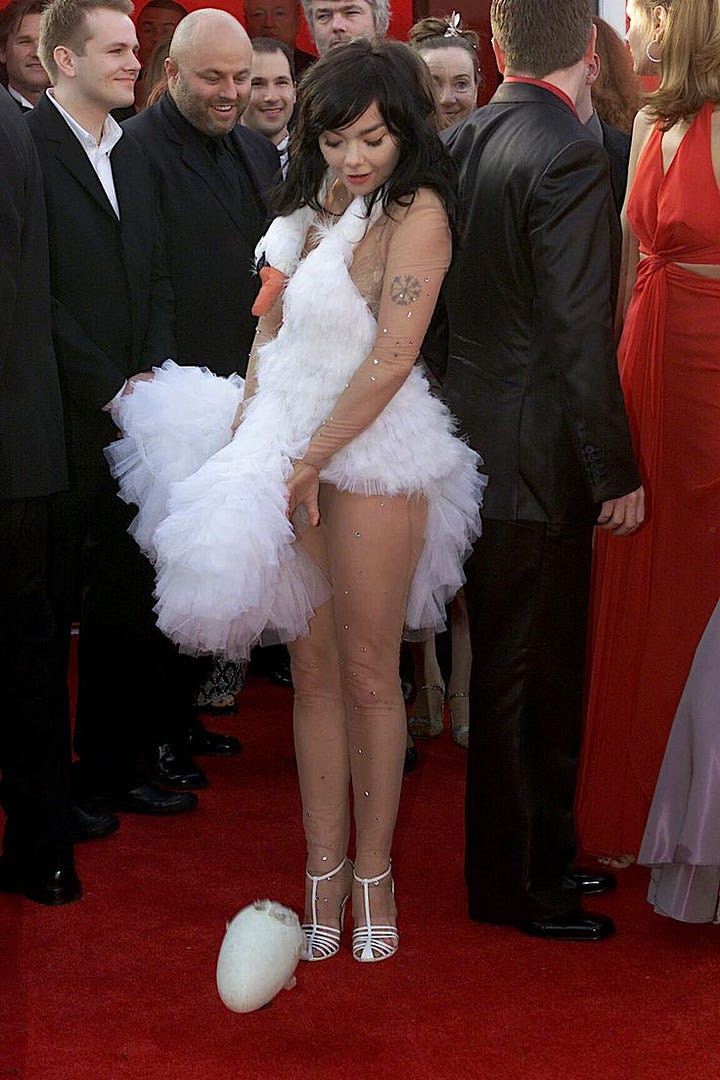
Something I talk about a lot is how personal style IS communication. It's the umbrella term for how you translate and communicate the parts of yourself that make up your personal style (the style part of your personality)-- said things include but are not limited to: taste, styling skills, nostalgia, change, limitations, interests, subcultures, preferences, et cetera. For most of us, some of these things are easier to communicate than others (see: next section on taste & communication).
Within the umbrella of personal style, taste plays an important and exciting role. It is one of the many internal factors that create our external expression of personal style.
Taste is rooted in personal opinion and a discerning eye, influenced but not wholly defined by external environments. It’s a skill, requiring exposure to diverse perspectives, art forms, and design paradigms to develop.
It represents what we value, crave, or feel a lack of, shaping how we engage with the visual, tactile, and conceptual beauty around us. It represents the juicy inner core of our creative eye (SO much more interesting and engaging than utilizing taste strictly as a symbol of signal or status) that informs and influences our style from the inside out- creating a symbiotic, personal, and creative relationship between the internal (taste, amongst other things) and external (personal style expression).
on that note, let’s touch on taste & how you communicate it:
Keep reading with a 7-day free trial
Subscribe to DIGITAL FRUITS to keep reading this post and get 7 days of free access to the full post archives.






